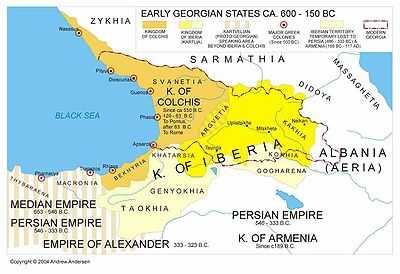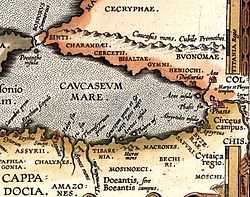Macrones
- Macrones is also a synonym of the fish genus Sperata.


The Macrones (Georgian: მაკრონები) (Ancient Greek: Μάκρωνες, Makrōnes) were an ancient Colchian tribe in the east of Pontus, about the Moschici Mountains (modern Yalnizçam Dağlari, Turkey[1]).
The Macrones are first mentioned by Herodotus (c. 450 BC), who relates that they, along with Moschi, Tabal, Mossynoeci, and Marres, formed the nineteenth satrapy within the Achaemenid Persian Empire and fought under Xerxes I. There are many other subsequent references to them in the Classical accounts. Xenophon (430-355 BC) places them east of Trapezus (modern Trabzon, Turkey). They are described as a powerful and wild people wearing garments made of hair, and as using in war wooden helmets, small shields of wicker-work, and short lances with long points.[2] Strabo (xii.3.18) remarks, in passing, that the people formerly called Macrones bore in his day the name of Sanni, a claim supported also by Stephen of Byzantium, though Pliny speaks of the Sanni and Macrones as two distinct peoples. By the 6th century they were known as the Tzanni (Ancient Greek: Τζάννοι). According to Procopius, the Byzantine emperor Justinian I subdued them in the 520s and converted them to Christianity.[3]
The Macrones are identified by modern scholars as one of the proto-Georgian tribes[4] whose presence in Northeastern Anatolia might have preceded the Hittite period, and who survived the demise of Urartu.[5] They are frequently regarded as the possible ancestors of the Mingrelians (cf. margal, a Mingrelian self-designation).[1]
The Macrones lived along the border with the Machelonoi, another "Sannic" tribe evidently closely related to the Macrones.[6]
References
- ↑ 1.0 1.1 Kavtaradze, Giorgi L. (2002), An Attempt to Interpret Some Anatolian and Caucasian Ethnonyms of the Classical Sources, pp. 63-83. Sprache und Kultur #3. Staatliche Ilia Tschawtschawadse Universität Tbilisi für Sprache und Kultur. Institut zur Erforschung des westlichen Denkens, Tbilissi.
- ↑ Herodotus ii. 104, vii. 78; Xenophon Anabasis iv. 8. § 3, v. 5. § 18, vii. 8. § 25; comp. Hecataeus Fragm. 191; Scylax, p. 33; Dionysius Periegetes 766; Apollonius of Rhodes ii. 22; Pliny the Elder (1st century AD) vi. 4; Josephus c. Apion. i. § 22, who asserts that they observed the custom of circumcision).
- ↑ Procopius Bell. Pers. i. 15, Bell. Goth. iv. 2, de Aed. iii. 6.
- ↑ Suny, Ronald Grigor (1994), The Making of the Georgian Nation: 2nd edition, p. 8. Indiana University Press, ISBN 0-253-20915-3
- ↑ Bryer, A. & Winfield, D. (1985). The Byzantine Monuments and Topography of the Pontos, p. 300. DOS 20 (Washington, DC), I. Cited in: Kavtaradze (2002), pp. 63-83.
- ↑ Edwards, Robert W. (1988), The Vale of Kola: A Final Preliminary Report on the Marchlands of Northeast Turkey, p. 130. Dumbarton Oaks Papers, Vol. 42.
![]() This article incorporates text from a publication now in the public domain: Smith, William, ed. (1870). "article name needed". Dictionary of Greek and Roman Antiquities. London: John Murray.
This article incorporates text from a publication now in the public domain: Smith, William, ed. (1870). "article name needed". Dictionary of Greek and Roman Antiquities. London: John Murray.
| ||||||||||